Menu
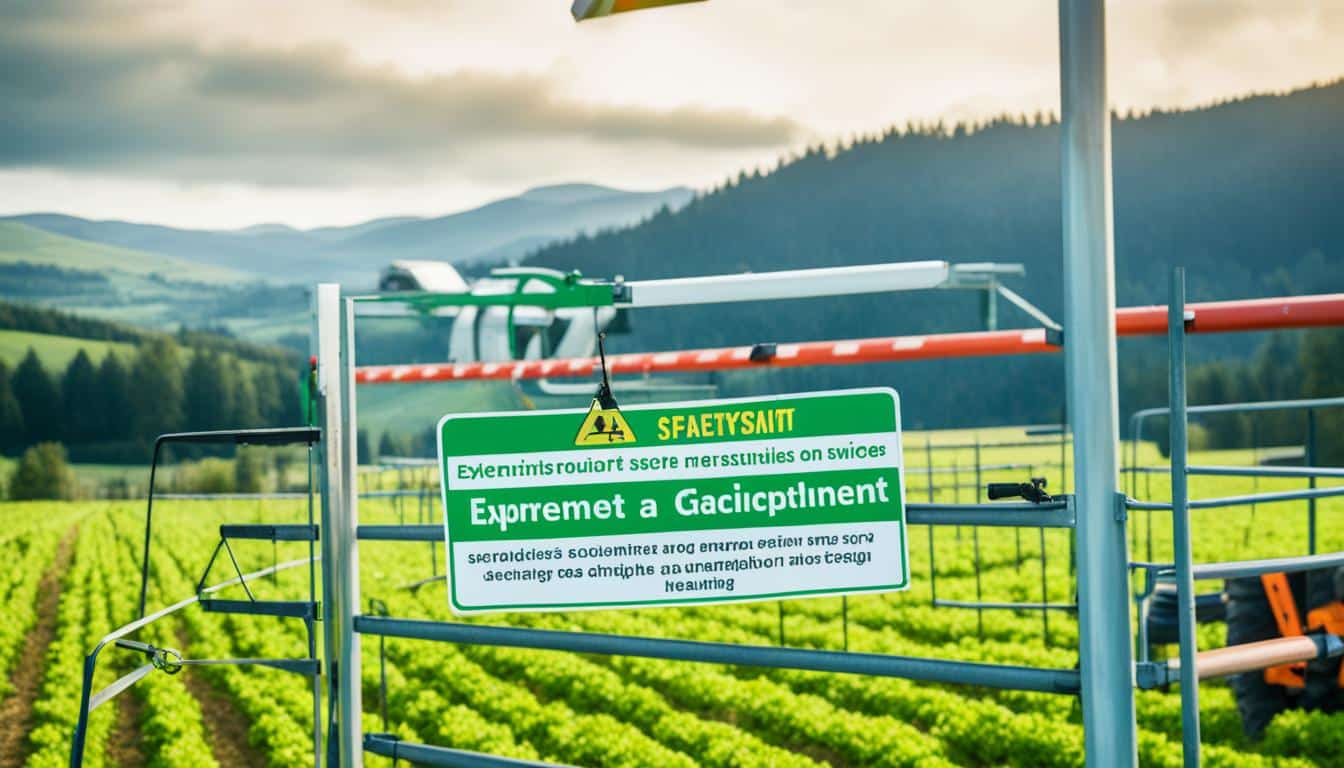
Imagine the bliss of a farm visit turning into an accident. What steps would you take then?
Agritourism merges rural tourism with farm activities and welcomes over 70 million yearly, 24 million being kids. From buying fresh produce to corn maze adventures, ensuring safety falls on the farmers. Knowing the risks and keeping up with safety practices can help prevent accidents and their consequences.
To make visits safer, farmers use tools like walkthroughs and checklists. These help them follow the best safety procedures for their agritourism sites.
Agritourism blends tourism with farm experiences, offering a chance to see agricultural life up close. This is a great way to escape the city but brings along some risks. It’s important to manage these risks well for everyone’s safety and to follow the rules.
A visit to a farm can bring dangers that visitors may not expect. Each farm poses its own risks. While these risks can be controlled, they can’t be completely removed. Sometimes visitors don’t follow safety rules, which increases the chances of someone getting hurt. Also, accidents, theft, and false injury claims are possible. It’s key to share and make sure visitors follow the farm’s safety guidelines to prevent these.
For those in agritourism, the rules about responsibility can change from state to state. It’s critical to have a strong safety plan that’s checked regularly to spot and fix any dangers. This includes having written safety guides with rules, steps to follow in emergencies, and who to call. With a plan that covers farm activities, risks, and safety zones, legal risks are reduced. Stick to the safe rural tourism safety guidelines to keep the farm safe for everyone.
Keeping farm visitors safe is essential in agritourism. Regular checks on where visitors go can protect them and cut down on risks. Make sure everyone knows what to do in emergencies. Also, limit access to dangerous areas to protect children. Good signs, clear safety rules, and places to wash hands well all help keep the farm fun but safe.
Following farm safety guidelines is key to preventing risks and caring for visitors and staff.
Running a safe agritourism farm means following many regulations. These rules are at the national, state, and local levels. By knowing and following them, you can prevent problems and keep everyone safe.
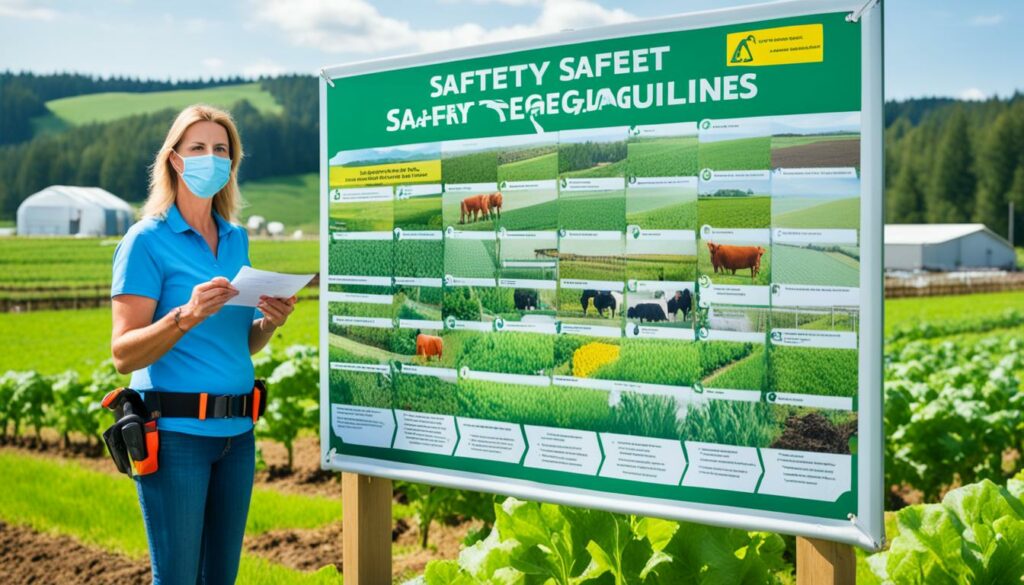
The U.S. government has rules that are key for farm safety. Everyone must follow laws like those from OSHA, FSMA, and ADA. This helps ensure that visitors and farm workers are protected on agritourism spots.
State laws on agritourism can differ a lot. Some states have special rules that help farms handle certain risks. But, if a farm is negligent, these rules may not fully protect them. It’s vital for farm owners to know and stick to their state’s laws. The National Ag Law Center is a helpful place to look for precise advice.
Regular farm inspections are critical for safety. They pinpoint areas that might be risky and allow for proper risk management. Keeping up with safety records, training staff, and telling visitors about risks are also key parts of keeping the farm safe.
| Regulatory Aspect | Details |
|---|---|
| Federal Compliance | Adhere to OSHA, FSMA, and ADA guidelines |
| State Regulations | Familiarise with state-specific agritourism statutes and legal obligations |
| Regular Inspections | Identify and mitigate hazards through consistent farm inspections |
To make agritourism safe, you need a reliable farm safety plan. This plan lists key safety rules and procedures. It helps keep everyone on the farm safe – residents, workers, and visitors. Each farm has unique risks that need checking often. This includes spotting hazards and taking steps to avoid them.
The farm safety plan must cover everything from where to park to how to handle animals. It should include clear steps for each activity and areas that are off-limits to avoid harm. Getting advice from experts, like extension agents, can really help when dealing with unknown dangers.
Training workers is very important. It teaches them how to stay safe, lift without hurting themselves, and what to do in an emergency. Keeping up with regular training and record-keeping are key to keeping agritourism safe.
This table shows some important parts of creating a farm safety plan:
| Safety Considerations | Actions |
|---|---|
| Managing potential safety hazards | Regular inspections, hazard identifications |
| Conducting employee training | Frequent training sessions, maintaining logs |
| Communicating risks to visitors | Clear signage, verbal instructions |
| Setting up emergency response procedures | Accessibility to first aid kits, emergency contacts |
| Regular farm inspections | Including building, equipment, livestock |
Thinking ahead to find and fix risks is key to keeping people safe on the farm. This shows that stopping accidents before they happen is the best strategy. A good farm safety plan helps run the farm well and keeps agritourism a safe and enjoyable experience for all.
Risk assessments help keep agritourism safe. It’s important to check every part of the farm for hazards. Think about what could be dangerous for visitors who might not know about farm risks.
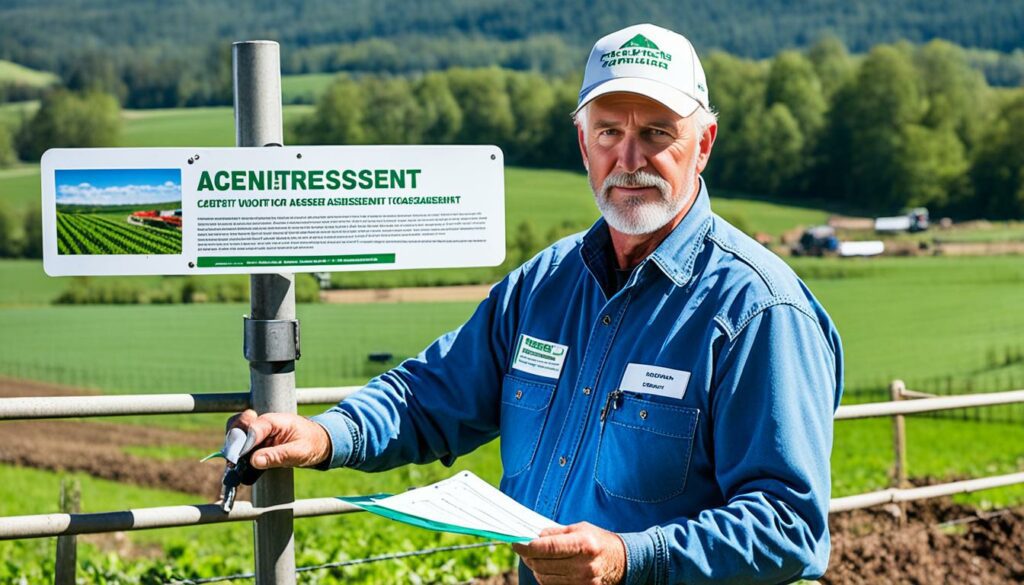
Make lists for different farm areas like parking and buildings. Farm safety risks are unique but can be managed. Getting advice from experts is really helpful in spotting these risks.
Looking after visitors, especially kids and the vulnerable, is critical. Make sure animals are safe, things are clean, and sick people don’t touch the animals.
Farm workers’ safety is also very important. They should know what to do in emergencies and where first aid and fire safety stuff is. Farm workers who are well trained make the farm safer for everyone.
| Aspect | Safety Measures |
|---|---|
| Parking | Ensure adequate drainage, visibility, and lighting to manage congestion effectively. |
| Buildings | Comply with building codes, maintain structures, and ensure clean and well-stocked facilities. |
| Animal Handling | Follow guidelines for cleanliness, proper containment, and limiting contact with vulnerable visitors. |
| Emergency Response | Prepare by practicing drills, locating essential emergency equipment, and training in first aid and CPR. |
Doing detailed risk assessments and having a good safety plan makes agritourism safer. This ensures both visitors and staff have a great time, free from harm.
Getting ready for emergencies is key in keeping agritourism going. A solid plan makes sure that accidents are dealt with quickly, which cuts down on harm and helps everyone work together. The National Fire Protection Association says getting ready for emergencies means doing things before they happen to stop, lessen, deal with, and recover from them. Everyone knows that emergencies can happen at any time and to anyone. So, being prepared is really important, especially in areas like agritourism.
Agritourism places, as they interact with the public on farms, need to think about making an emergency plan that’s just for them. This means having the whole management team on board, making sure customers and staff are safe, keeping the business running, and having extra equipment and plans ready. It’s also key to keep checking and updating the plan after any emergency.
Making sure visitors and staff know how to stay safe and who to tell in case of an emergency is crucial. Having a plan written down helps everyone be ready for emergencies, making farms safer for all.
Farm staff training is crucial for keeping both visitors and workers safe. All team members need to know about safety and risk management. They should be well-educated to make sure the farm is a safe and fun place for everyone.
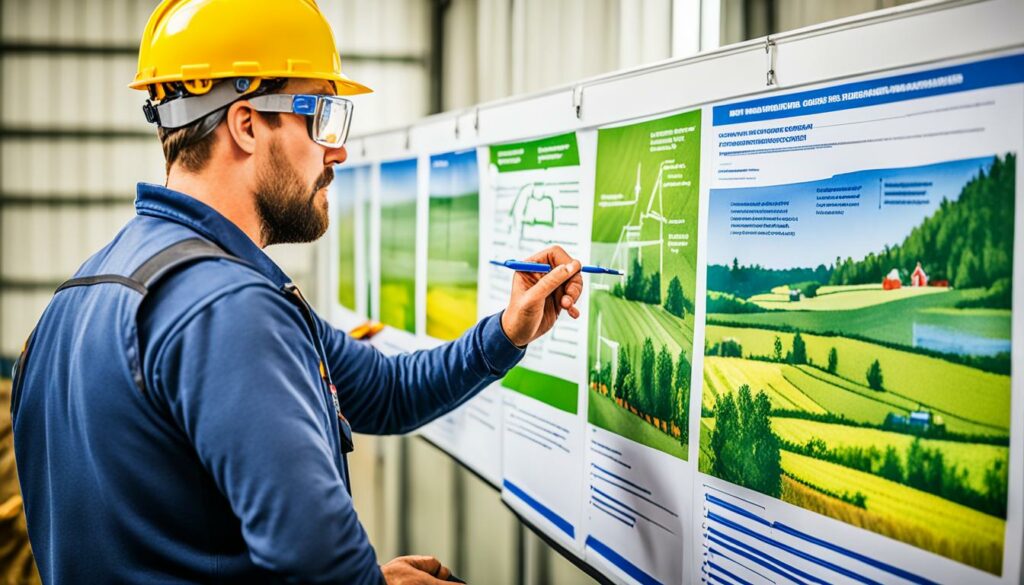
Training staff often is key to running a safe farm. It helps them spot dangers, understand safety rules, and do their jobs well. This safety culture protects visitors and cuts down on the farm’s legal risks.
Every worker must learn first aid and CPR. Knowing these skills means they can act fast in an emergency. This makes the farm safer for everyone. With these abilities, workers can quickly help with injuries or sudden sickness, which lowers the risks.
It’s vital to keep records of all training. This not only shows our focus on safety but also helps in legal cases. Documenting training keeps our safety rules on track and makes sure we keep them up to date and follow them well.
Telling visitors about safety rules is key for rural tourism. It’s important to show them the visitor guidelines through clear signs and talking to them. This makes sure everyone behaves well on the farm.
Checking play equipment often keeps it safe and stops accidents. Having rules for being near animals, with clear signs, also helps prevent problems.
Guided tours with experts help visitors follow the rules. Plus, having places to wash hands near animals or food keeps things clean and safe.
Having a plan for emergencies and practicing it with local help is vital. Working in clean food areas increases trust and happiness for visitors.
Signs all around show what to do for safety. Putting up Act 31 signs at activities makes visitors aware of dangers, avoiding accidents.
| Safety Measure | Implementation |
|---|---|
| Equipment Inspection | Regular checks for wear and tear |
| Animal Interaction Protocols | Informational signage and staff guidance |
| Hand-Washing Stations | Install at key points |
| Emergency Response Plan | Collaborate with local authorities and conduct drills |
| Informative Signage | Highlight safety practices and expectations |
| Act 31 Signs | Display at activity entrances |
In Pennsylvania, activities like picking your own fruits or veggies and corn mazes are popular. The ‘Integrating Safety into Agritourism’ programme helps farms reduce risks with useful tools. It supports making farms safer for everyone.
Checking paths and having signs with the farm’s name nearby is very important. A farm must also have first aid ready with easy-to-see signs for help.
Having a way to report accidents and making sure everyone knows what to do in emergencies is part of good safety management. It makes applying the visitor rules part of how a farm works, keeping everyone safe.
Running agritourism means making sure animals are safe and healthy when interacting with visitors. A solid plan focused on animal welfare is crucial.
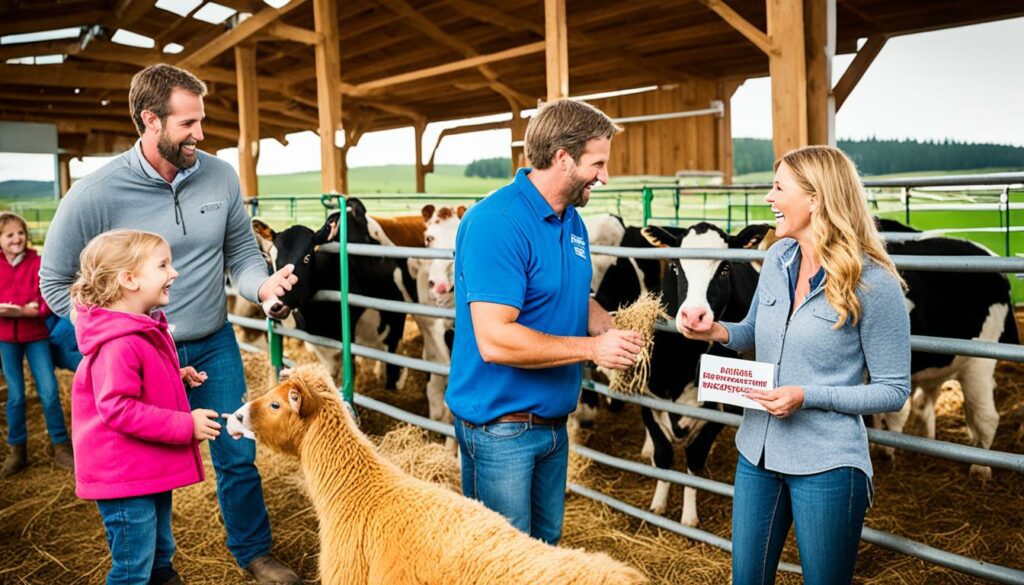
Animals on these farms need regular check-ups and vaccinations. They must be clean and watched for any sickness. Doing this helps the animals stay healthy and stops diseases from spreading to visitors.
It’s important for visitors to stay safe around animals. Signs should show how to behave. And, there should be places to wash hands so that people are clean after touching animals, making sure both visitors and animals are safe.
Animals must stay where they belong, in safe areas, for everyone’s well-being. Strong barriers stop people from getting too close. Signs, booties, or hand-cleaning stations help prevent illnesses spreading between farms.
Agritourism businesses should plan well. They need rules for how visitors can feed, pet, and be around animals safely.
This is an example of a safety plan for farms where visitors interact with animals:
| Activity | Risk | Safety Measures |
|---|---|---|
| Animal Feeding | Potential bites or scratches | Supervised feeding, clear instructions |
| Hay Rides | Falls or tripping | Proper seating, secure entry/exit |
| Petting Areas | Animal stress or visitor injury | Controlled access, staff supervision |
| Parking | Traffic congestion | Directional signage, staff assistance |
| Food Service | Contamination | Health compliance, handwashing facilities |
Making sure animal interactions are safe makes the visit more fun. It also protects the well-being of both visitors and animals.
Agritourism invites people to farms, where they might not know the dangers. It is important to have strong agritourism safety strategies. These strategies should protect both visitors and the people running the farm. Every farm should have a safety plan that reduces risks for guests and avoids legal trouble.
Each farm that welcomes visitors must regularly check for dangers. Because accidents can happen on farms, being prepared is crucial. This includes preventing accidents and knowing how to act fast if something does go wrong.
Identifying the dangers that are specific to each farm is key. Things like parking, traffic, building upkeep, and taking care of animals need a close watch. It’s also important to clearly tell visitors about any possible risks and what they need to do to stay safe. This can be done through signs and by talking to them directly about safety rules.
The table at the bottom of this page shows important aspects of safety in agritourism. It lists common dangers and ways to deal with them:
| Area of Concern | Common Hazards | Mitigation Strategies |
|---|---|---|
| Parking and Traffic | Visibility issues, inadequate parking spaces | Clear signage, adequate lighting, designated parking areas |
| Building and Bathroom Maintenance | Inadequate lighting, cleanliness issues | Regular inspections, following building codes |
| Animal Handling | Anmal bites or infections | Proper enclosures, health monitoring |
| Hayrides | Falls, equipment malfunction | Safety briefings, regular equipment checks |
| Fire Prevention | Combustible materials | Proper storage, accessible fire extinguishers |
Following these risk management tips keeps safety first. Checking the farm, spotting risks, and stopping them before they happen are vital. They help make your agritourism safe and enjoyable for everyone.
Keeping food safe in agritourism must follow strict health rules. These rules are key to good sanitation and stopping illnesses. Each year, 76 million in the US get sick from common bugs like Escherichia Coli, Salmonella, and Shigella.
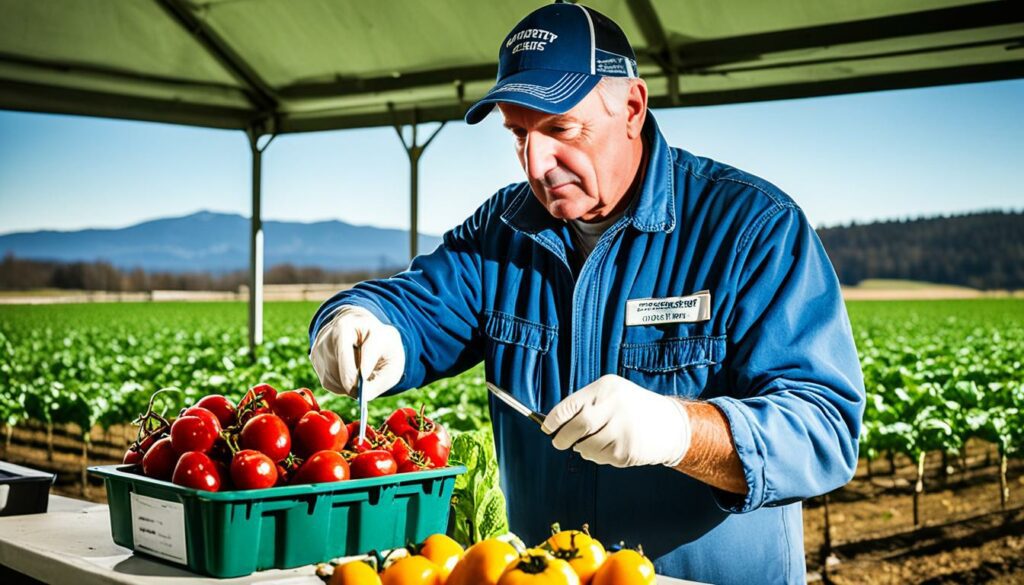
Every agritourism farm needs to obey health department rules. This means food must be stored, made, served, and sold right. Inspections check that rules are always followed, keeping the farm and visitors safe.
Good food handling is essential. It involves thorough hand washing, using gloves, and keeping food areas clean. Labeling and handling food correctly also help. For example, in 1996, a strawberry scare led to nearly $40 million in lost sales. This shows the need for strict food safety.
Stopping contamination is key. It can come from germs, chemicals, or objects. Farms must provide clean places to wash hands and have strict cleanliness rules. They also train staff about dangerous germs. Since 1990, sales of organic food have increased by over 20% a year. Now, 73% of regular stores sell organic. This shows people want food that’s safe and made in a good way.
| Common Pathogen | Impact |
|---|---|
| Escherichia Coli | Severe gastrointestinal illness |
| Salmonella | Food poisoning, often severe |
| Shigella | Diarrhea, fever, stomach cramps |
In short, safe food in agritourism relies on following health rules, handling food right, and preventing contamination. These steps are crucial for keeping visitors healthy and ensuring agritourism stays trustworthy.
To make sure every visitor has a great time on the farm, we must follow the Americans with Disabilities Act (ADA). This helps us cater to the needs of all, showing our commitment to accessible agritourism.
Following the ADA isn’t just a must-do; it’s key to making agritourism open to everyone. It involves making sure our spaces and services help visitors and staff who have disabilities. Farm owners can learn more about this from the Department of Justice or local Small Business Administration (SBA) offices.
For agritourism to be truly open, certain facilities and spaces need special attention. Things like walkways, parking, and restrooms should be easy to use for those with disabilities. Essential features include ramps and wide doorways, plus clear signs.
Keeping everyone safe is a top priority. This means staying up to date with ADA laws to ensure facilities are secure and welcoming for all. Safety plans should also cover how to help visitors with disabilities and train staff accordingly. This way, everyone has a smooth, enjoyable visit.
Fire safety is key in agritourism. Farms carry risks, making it crucial to keep visitors and the farm itself safe. Good safety practices mean following local rules and making guests feel secure.
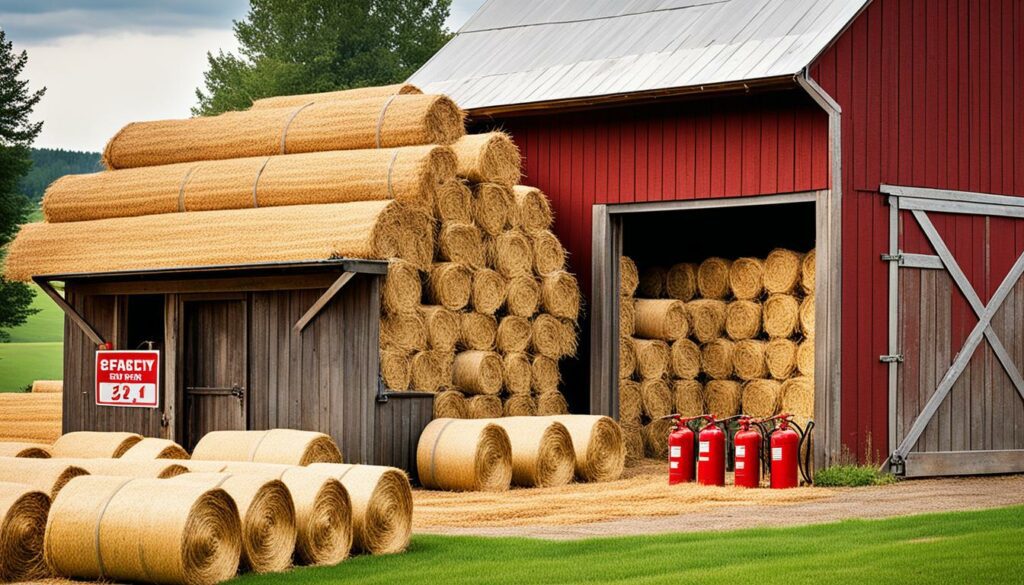
Storing flammable items right is essential in agritourism. All things like fuel and chemicals must be in safe places. There should be clear signs and areas just for these materials to lessen the risk of fires. Regular checks on these areas help with keeping the farm safe from fires.
Having working fire extinguishers is vital on a farm. They should be in easy-to-reach places, especially where fires may start. Check them often to ensure they work. Making sure everyone knows how to use them means a quicker response to fires.
Making and updating an evacuation plan is very important. It tells everyone what to do in an emergency. Regular practice and training make sure the plan works well. Signs showing what to do in an emergency also help keep everyone safe.
In December 2019, the importance of safe farm buildings and bathrooms was highlighted. This was in relation to agritourism activities. It’s vital to ensure public areas follow building codes. This makes everyone, both visitors and owners, feel safe.
To make agritourism buildings safer, do a safety check before guests arrive. This checks for possible dangers to stop accidents. The law in Virginia (§36-99) says farm buildings must mainly be for farming to avoid some building code rules. Making sure buildings are safe is essential for visitors and to follow the law.
Keeping visitors away from danger is smart. Place workers or volunteers around the farm to help visitors and prevent accidents. I always make sure paths are clear and well-lit to reduce falls.
For a good agritourism experience, operators must have clean, safe toilets. They should place these in good spots. Also, keep handwashing stations and clear signs for clean hands. This is key to not just for visitor health but also to reduce risks when around animals.
Set farm tour rules, mark danger zones clearly, and have first aid and fire safety gear ready. These steps help deal with accidents fast. Use this guide to get your farm ready for visitors.
In short, keeping agritourism buildings and bathrooms safe is key for a successful and secure business. It protects visitors and boosts the farm’s image as a safe, welcoming place.
Keeping parking and traffic smooth is vital for farm visits to be safe and easy. Using clear signs, managing when there are lots of visitors, and having enough light are key.
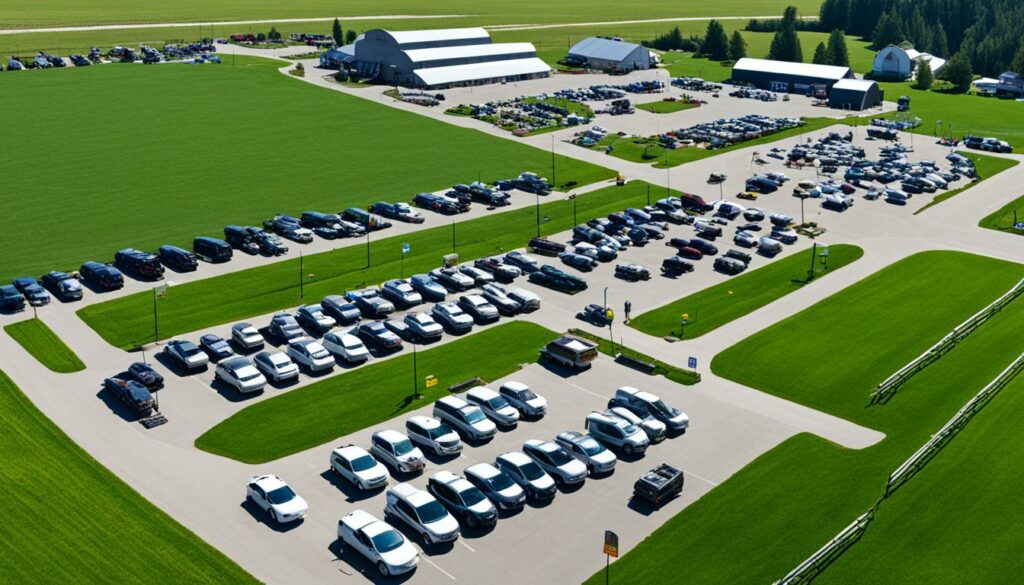
Signs play a big part in keeping traffic moving at the farm. They show the way from the entrance to where visitors park. This stops people getting lost and helps everyone stay safe.
Lots of visitors at once can lead to traffic jams and dangers. To avoid this, planning visits on weekends and holidays is a good idea. A ready team can help direct traffic and keep things running smoothly.
Good lighting, especially after dark, is a must. It makes parking spots and paths safer, preventing falls and problems. This is key at times when the sun doesn’t give enough light.
Being ready for bad weather, like rain, is important for traffic plans. Using different spots for arriving and leaving by car and having a place just for buses shows a farm is safe and organised.
| Key Consideration | Details |
|---|---|
| Clear Signage | Directional signs for entry, parking areas, and exits |
| Peak Times Management | Scheduled visits, staff assistance in traffic flow |
| Adequate Lighting | LED lights for all parking areas and pathways |
| Adverse Weather Planning | Separate entry and exit points, designated bus drop-off zones |
Agritourism safety goes beyond just following the law. It shows a strong promise to offer a memorable and safe visit to the countryside. Every farm faces their own risks. But by managing them well, most dangers can be avoided. Agritourism safety starts with looking at all the risks. Then, farms make plans that are perfect for their own needs and ways of doing things.
Keeping farms safe involves many steps. Workers need to keep learning about safety. Risks and how to stay safe need to be clearly explained to visitors. And it’s important to always check that safety rules are working and up to date. Inspecting regularly, spotting dangers, and making sure everything like parking spaces and toilets is safe is key. This ensures a farm visit is enjoyable but also very secure.
It’s vital for agritourism places to always be aware of new safety rules and potential dangers. Seeing safety not as a one-time goal, but a continuous mission makes a big difference. It helps visitors and staff feel secure. Keeping a safe agritourism operation alive means these rural spots can be fun and educational while also being safe. With hard work and a promise to keep improving, agritourism can stand out for its safety and visitor joy.
Agritourism safety is all about keeping places clean and safe. This means checking things often and sticking to the rules. Everyone should know how to be safe, which helps visitors and farm workers stay out of harm’s way.
It’s vital to know the dangers in agritourism to keep people safe. Being aware lets farm owners make their places safer for everyone. It ensures they follow safety laws too.
To lower risks, farm owners should have detailed safety plans and follow laws. They should check for dangers often, train their staff well, and make sure visitors know the rules. This approach helps prevent accidents and can reduce harm.
Agritourism farms must obey safety and health laws set locally and nationwide. They need to regularly check these laws and keep up with any legal changes. This makes sure the farm remains both fun and safe for guests.
Any safety plan should have clear rules, how to act in emergencies, and how to run every activity safely. It must say which areas are off-limits and when staff trains. Contact details and emergency prep should also be there.
They should look at the whole farm with visitors’ eyes and get advice from experts. Updating checks and focusing on kids’ safety help too. This continual process is key to spotting and fixing hazards.
First aid kits, fire gear, easy to find emergency contacts, and practising with staff are vital. Teaching first aid and CPR to workers is crucial for fast, effective help. These steps can save lives or prevent severe injuries.
Training farm workers on safety is critical for keeping agritourism safe. It prepares them to handle all farm activities well and respond in emergencies. Keeping records of training shows the farm values safety, which is good for the law.
Safety guidelines should be easy to see and understand. Signs and talking to visitors work well. Having written plans for every activity also helps. This means everyone knows how to be safe, cutting risks and ensuring fun.
Only healthy and vaccinated animals should meet guests, with proper signs and after-touch cleaning stations. For visitors from other farms, using booties or cleaning washes can stop the spread of illness. This keeps everyone safe around the animals.
Giving danger a serious look, controlling it, and teaching visitors and workers are major steps. Updating safety often is crucial, as is making safety part of the visit. This keeps risks low and everyone safe.
They should follow health rules, store food right, and keep food areas clean. Workers must know about keeping things hygienic too. Having places to wash hands and being strict about cleanups help stop food from making guests sick.
Places must follow the Americans with Disabilities Act (ADA) to be open to all. Buildings, paths, and activities should work for people with any ability. Getting help from government resources can make the farm welcoming for everyone.
By storing flammable stuff well and keeping fire equipment and alarms in shape. Also, training workers and saying no to smoking help. Clear signs for emergencies add to a farm’s safety.
Make sure buildings and toilets follow rules, are lit well, and kept clean. Putting up more wash places and keeping risky areas locked helps. Checking often keeps these places safe and enjoyable for guests.
Use signs and make sure cars can be seen and parked right, especially during busy times. Good lights, plans for bad weather, and bus areas make visits smooth and safe. It’s all about planning for everyone’s well-being.